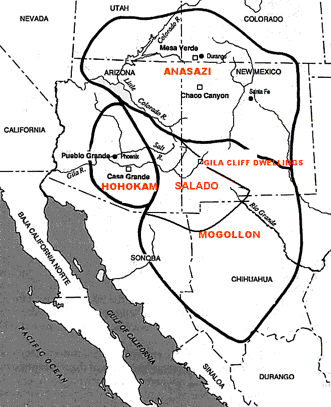 ClayHound Web
- Salado
Pottery
ClayHound Web
- Salado
PotteryReturn to:
|
SALADO POTTERY |
|||||||||
|
|
|||||||||
|
Tonto National Monument, Arizona |
|||||||||
|
Excellent information from the Logan Museum of Anthropology on line from Beloit, Wisconsin |
|||||||||
|
All text and images are used courtesy
of the Logan Museum of Anthropology, Beloit College |
|||||||||
|
Inhabiting the Tonto Basin in central Arizona for the relatively short period between A.D. 1150 and around A.D. 1450, the Salado culture was named for the Salt River (Rio Salado in Spanish) that was central to their way of life. Considered a minor culture by archeologists, the Salado culture's origins are still being debated. The first wave of Anasazi influence was accompanied by the adaptation of certain northern black-on-white pottery types, such as Tularosa Black-on-White. The new type, Roosevelt Black-on- White, has all of the decorative elements of the Tularosa style, but differs in physical characteristics. The second wave saw the dissemination of polychrome pottery types such as Wingate and St. Johns. These evolved locally into Gila, Tonto and Pinto polychromes. These latter pottery types fall into the category of Roosevelt Red Ware. |
|||||||||
|
|
|||||||||
|
Roosevelt Red Ware Roosevelt Red Ware comprises a number of types produced in the middle Gila River area, between Phoenix and the New Mexico border. Of particular interest are the Salado polychromes, which were widely traded and are easy to recognize. Rather than black and white paints applied to a red-slipped base, as in other Anasazi polychromes, Salado polychromes have black paint applied to a white-slipped zone (either the interior of a bowl or a portion of the exterior) with no painting in the red-slipped zones.
Material: The clay is sometimes tempered
with mica flakes, giving the surface of vessels a glittery aspect.
From: http://www.beloit.edu/~museum/logan/southwest/salado/salado.htm |
|||||||||

 The
Salado are believed to have been a group of wayfaring Anasazi who
experienced moderate Mogollon influence and migrated into the Tonto
Basin/Roosevelt Lake/Globe, Arizona region.
The
Salado are believed to have been a group of wayfaring Anasazi who
experienced moderate Mogollon influence and migrated into the Tonto
Basin/Roosevelt Lake/Globe, Arizona region.

